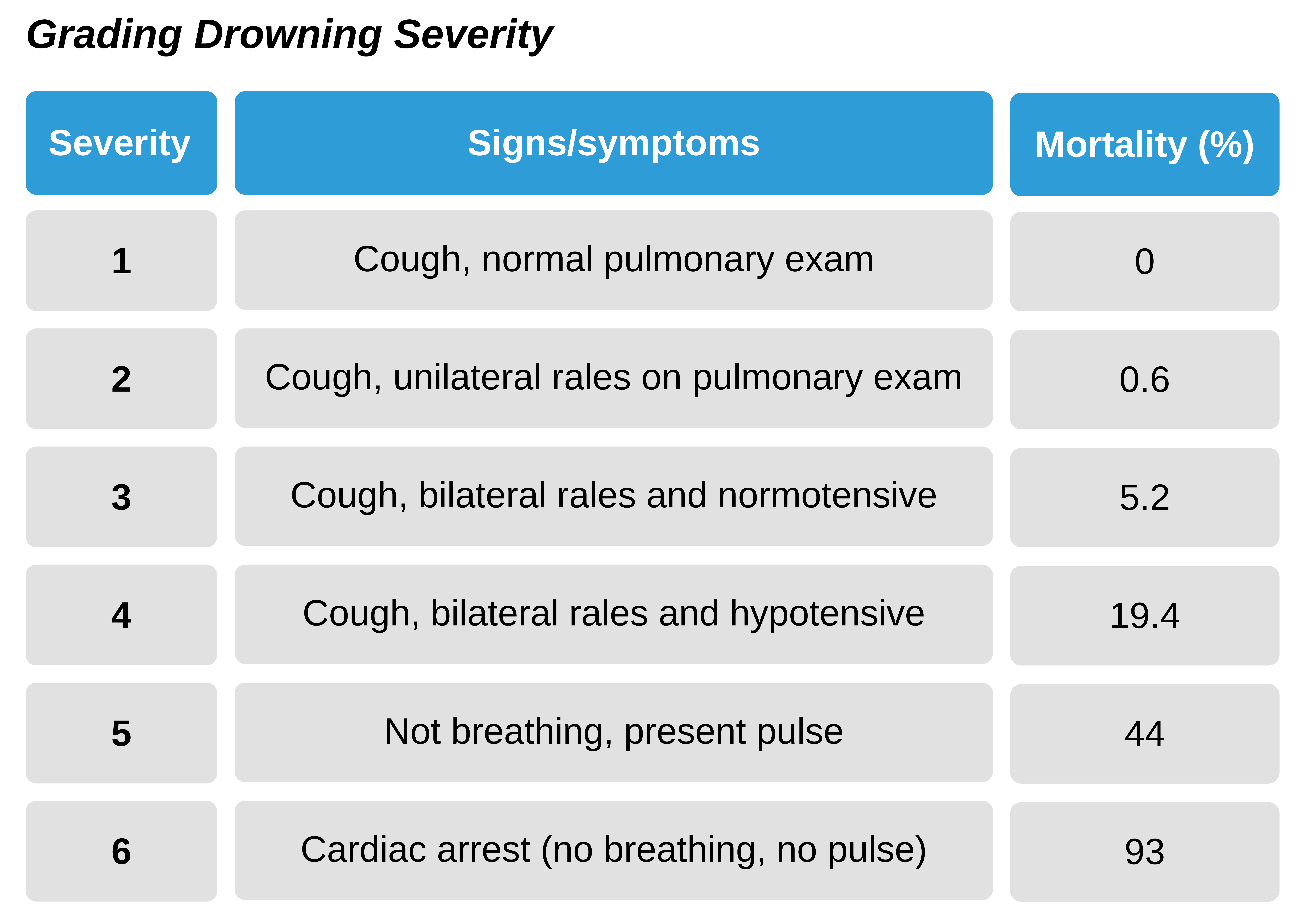Outcomes in Drowning
Defining Drowning
There are some specific criteria, called the Ulstein definitions, regarding drowning and related scenarios:
- Drowning: this is respiratory distress/arrest secondary to either submersion or immersion in fluid, precluding gas exchange. Patients may or may not survive the event.
- Immersion: the act of being covered by water
- Submersion: completely covered by water, which includes the airway
- Water rescue: distress associated with swimming, but the patient remains alert. There are minimal and temporary symptoms (i.e., coughing) that resolve quickly.
Drowning related incidents are evaluated based on the length as well as the severity of the episode.
Predicting Outcomes
There are certain challenges when determining the drowning patient’s long-term prognosis. Prognosis will help determine which patients should receive resuscitative efforts. Research suggests that for patients of drowning 20 years and younger, the length of submersion was the most important factor in long-term outcomes. Not surprisingly, the longer the submersion, the higher the risk of long-term brain damage or death:
- Under 5 minutes: 10 % risk
- Between 5-10 minutes: 56% risk
- Between 10-25 minutes: 88% risk
- Over 25 minutes: 100% risk
This research indicates that submersion under 5 minutes significantly improves outcome even compared to another 5 minutes (as seen in the 5-10 minute group). The following factors are 100% associated with mortality
- Submersion over 25 minutes
- Resuscitation over 25 minutes
- PEA at ED arrival
- Persistent coma following the drowning
On the other hand, those that have ROSC soon after resuscitation efforts usually do well with good neurological function. There have been attempts at grading drowning severity to determine long-term outcomes. One such study uses cardiac and respiratory functioning to determine severity.

It is useful to identify information about the patient and situation as most initial resuscitation events occur outside of the hospital. Note that many patients who do well may not ever go to the hospital. Data that should be obtained include
- Patient information
-
- Name and identification
- Demographics
- Inciting event
- Past medical history/comorbidities
- Scene Information
-
- Witness
- Location (i.e., pool, beach, bath, type of fluid)
- Timing of CPR (bystander or EMS)
- Initial vitals and neurologic status
- Evaluation in the ED:
-
- Vitals
- laboratory findings
- Neurologic exam
- airway concerns
- Hospitalization:
-
- Airway concerns
- Neurologic function
- Comorbidities
- Disposition:
-
- Survival?
- Long-term neurologic function,
- Date of discharge
Inciting Event
If possible, the inciting event of the drowning should be documented. It may be related to the patient’s medical condition or an injury. For example, a seizure is a common inciting event. Additionally, any condition that decreases consciousness or causes significant pain such as ACS, concussion, stroke, or hyperventilation prior may play a factor.
Additionally, there is a possibility of suicide, homicide, or abuse at play. Of course, drugs that impair the senses, such as alcohol and an illicit drug, can make drowning more likely. Note that these inciting events may increase mortality.
Time Interval
The time interval of submersion is a proxy of the interval of hypoxia. While bystanders estimate is often inaccurate, this information can be prognostic.
Outcome
The main outcomes are death or survival. Death from drowning includes both immediate death at the scene or at ED arrival as well as death that is related to the sequelae of drowning, such as
- Brain death secondary to significant hypoxemic brain injury
- Acute respiratory distress syndromes
- Multiple organ failure secondary to hypoxemic injury
- Sepsis secondary to aspiration pneumonia or other hospital-associated infections
Post-hypoxic encephalopathy can commonly lead to death in these patients. while most of these deaths will occur in the first days or weeks, mortality can extend beyond this period. There is no cut off time if the death is irrevocably linked to the drowning event.
Deciding on resuscitation
The majority of drowning patients in cardiac arrest after being rescued from will die. However, some will survive. Generally, 50% of patients who have been submerged between 5-10 minutes will be pulseless at rescue from the water. However, these guidelines are not universal, and some patients in this group survive:
- Of the drowning patients in cardiac arrest at the rescue, essentially all will have ROSC at the scene, and before ED arrival
- ROSC will need to occur within 25 minutes of starting CPR for a chance at survival
- Survival after prolonged submersion, while very rare, may be more likely with icy water.
Consequently, all patients should be given a trial of resuscitation unless obvious signs of death are present (i.e., rigor mortis, lividity)